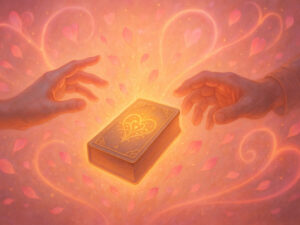How to Use Tarot for Emotional Healing & Find Peace Within


Table of Contents
In the quiet corners of our lives, many of us search for pathways to greater emotional peace, seeking ways to understand the currents that flow beneath the surface of our daily experiences. We look for tools that can help us navigate the complexities of our feelings, hoping to find clarity and release. While traditional methods abound, there exists an ancient practice, often shrouded in mystique, that offers a surprisingly potent avenue for inner exploration: the Tarot. Often associated primarily with fortune-telling, the Tarot holds a deeper potential, serving as a compassionate and insightful guide on the journey toward emotional healing and self-discovery.
Using Tarot for emotional healing isn’t about predicting a fixed future; rather, it’s an introspective practice centered on fostering profound self-reflection. It involves engaging with the rich symbolism and archetypal imagery of the cards to gain insight into our deepest feelings, uncover hidden patterns, and gently untangle the knots of past experiences. It’s a way to hold up a mirror to our inner world, illuminating aspects of ourselves that might otherwise remain in shadow. Through this process, we can begin to achieve a newfound clarity about our emotional landscape, identify and release blocks that hold us back, feel more empowered in our choices, and ultimately, connect more deeply with our own innate wisdom.
This exploration will delve into how these seventy-eight cards, far from being mere tools of divination, can become trusted companions on your path to emotional well-being. We will uncover how Tarot can facilitate self-awareness, aid in processing difficult emotions, catalyze personal growth, and offer gentle guidance when the way forward seems unclear. Join us as we explore the transformative power of Tarot as a supportive resource for navigating your inner world and cultivating lasting emotional resilience and peace.
Beyond Prediction: Understanding Tarot’s Role in Emotional Wellness
For centuries, the Tarot has captured the human imagination, often depicted in popular culture as a mystical tool wielded by fortune-tellers to unveil secrets of the future. While this predictive aspect has its place in Tarot’s long history, a significant evolution has occurred, particularly in recent decades. Increasingly, practitioners and seekers alike are recognizing Tarot not just as a system for divination, but as a profound instrument for introspection, psychological insight, and deep emotional healing. This shift moves Tarot from the realm of predicting external events to the landscape of understanding our internal world, transforming it into a powerful ally for enhancing emotional wellness.
The core of Tarot’s healing potential lies in its remarkable ability to act as a mirror to the soul. The seventy-eight cards, with their intricate tapestry of symbols, characters, and scenarios, reflect back to us the often-unseen aspects of our own psyche. When we engage with the cards thoughtfully, they can illuminate subconscious thoughts, bring hidden emotions to the surface, and reveal ingrained patterns of behavior that shape our experiences and relationships. It’s like having a conversation with a deeper part of yourself, the part that holds wisdom and understanding often obscured by the noise of daily life. The images bypass the rational mind, speaking directly to our intuition and emotional centers, allowing for insights that might not emerge through logical analysis alone.
This reflective power is amplified by the universal language of symbolism and archetypes embedded within the Tarot deck. From the nurturing embrace of The Empress to the challenging lessons of The Tower, or the introspective journey of The Hermit, these archetypal figures and situations resonate with fundamental human experiences. They represent universal energies, struggles, and triumphs that are part of the collective human story. When we see these archetypes reflected in a reading related to our own emotional state, it can create a powerful sense of connection and understanding. We realize our personal struggles are part of a larger human narrative, which can be incredibly validating and reduce feelings of isolation. The symbolism provides a framework, a language, through which we can explore complex feelings and situations that might otherwise feel overwhelming or difficult to articulate.
Crucially, using Tarot for emotional wellness involves a fundamental shift in perspective regarding challenges and difficulties. Instead of viewing challenging cards as portents of inevitable doom or fixed negative outcomes, this approach sees them as invitations— opportunities for growth, healing, and deeper self-awareness. A card like the Ten of Swords, often depicted with a figure pierced by swords, might not signify literal disaster but could instead point towards the necessary end of a painful cycle, the need to release old burdens, or the rock bottom from which rebuilding can begin. Similarly, The Devil might represent not an external evil force, but the internal chains of addiction, negative thought patterns, or limiting beliefs that we have the power to confront and break. By reframing challenges presented in the cards as signposts on our healing journey, Tarot empowers us to engage proactively with our difficulties, transforming them from sources of fear into catalysts for profound personal transformation and emotional resilience.
Unlocking Inner Peace: The Healing Benefits of Engaging with Tarot
When approached with intention and openness, the Tarot unfolds as a remarkable resource for nurturing emotional well-being. Its symbolic language offers a unique way to access inner landscapes, fostering healing and growth in multifaceted ways. Engaging with the cards can illuminate the path toward inner peace by facilitating deep self- awareness, enabling emotional release, empowering personal growth, providing clarity, validating our experiences, and deepening our spiritual connection.
Perhaps the most immediate benefit of using Tarot for emotional healing is its power to catalyze Self-Reflection and Deeper Awareness. The cards act as prompts, nudging us to look within and examine feelings or situations from new angles. Pulling a card like the Four of Cups might invite reflection on feelings of apathy or disconnection, prompting questions about what truly nourishes us. The High Priestess could encourage us to listen more closely to our intuition and subconscious messages. This process helps bring clarity to complex emotional states or confusing life circumstances. By consistently engaging in this reflective practice, we start to recognize recurring themes or patterns in our thoughts, feelings, and behaviors – perhaps a tendency towards self-sabotage revealed by the reversed Knight of Swords, or a pattern of avoiding emotional vulnerability suggested by the Three of Swords. This heightened awareness is the crucial first step towards conscious change and healing.
Beyond awareness, Tarot provides a powerful container for Emotional Release and Processing. Life inevitably brings experiences of grief, anger, fear, and disappointment. Sometimes, these emotions become stuck, creating energetic blocks that hinder our well-being. Tarot offers a safe, non-judgmental space to acknowledge and explore these difficult feelings. Drawing cards around a specific emotion can help articulate its nuances and even uncover its roots. For instance, exploring anger through cards might reveal underlying hurt (Five of Cups) or a feeling of powerlessness (Eight of Swords). This process of naming and understanding is inherently therapeutic. Engaging with the cards, perhaps through journaling or quiet contemplation, can facilitate catharsis – a release of pent-up emotional energy. It allows us to gently confront and process emotional baggage, gradually letting go of what no longer serves us and making space for healing.
This journey of awareness and release naturally leads to Personal Growth and Empowerment. The insights gained from Tarot readings are not merely interesting observations; they are potent guides for positive life changes. When the cards highlight areas needing attention – perhaps a need for better boundaries (Queen of Swords) or the courage to pursue a passion (Ace of Wands) – they empower us to take action. Regularly consulting the Tarot can also strengthen our connection to our own intuition.
We learn to recognize the resonance of certain messages and trust the inner guidance that arises during readings. This fosters a sense of agency; instead of feeling adrift, we begin making conscious choices aligned with our personal values and healing goals. Seeing ourselves navigate challenges and grow through the insights offered by the cards builds self-confidence and reinforces our capacity for self-discovery and transformation.
In times of uncertainty or transition, Tarot serves as an invaluable tool for Finding Clarity and Direction. When faced with difficult decisions or feeling lost, the cards can offer much-needed perspective. A reading might not provide a simple ‘yes’ or ‘no’ answer, but it can illuminate the factors involved, potential obstacles (perhaps The Chariot reversed suggesting lack of control), and possible outcomes based on different approaches (like The Star offering hope and inspiration). Exploring options through the cards helps weigh possibilities and connect with intuitive feelings about the best path forward. This process demystifies uncertainty, transforming overwhelming confusion into navigable terrain and fostering a sense of confidence in moving forward.
Furthermore, the Tarot offers profound Validation and Self-Compassion. In a world that sometimes dismisses or misunderstands emotional pain, the cards can affirm the reality and validity of our feelings and experiences. Seeing your struggle reflected in a card like the Five of Pentacles (representing hardship or feeling left out) can be deeply validating – a silent acknowledgment that your pain is real. This validation is crucial for healing. Moreover, the messages often encourage a gentler, more compassionate stance towards oneself. The Queen of Cups might remind you to nurture your emotional needs, while Temperance suggests finding balance and patience. Engaging with Tarot in this way helps cultivate kindness and understanding towards ourselves, counteracting harsh self-criticism and fostering a more supportive inner dialogue.
Finally, for many, using Tarot for emotional healing deepens their Spiritual Connection. Whether one views spirituality in terms of connection to a higher power, the universe, nature, or simply one’s deepest self, Tarot can serve as a bridge. The practice encourages mindfulness, requiring presence and attention to the images and the feelings they evoke. It fosters a dialogue with intuition and the subconscious, often considered gateways to spiritual insight. Pulling cards can become a ritual, a sacred pause in the day to connect with inner wisdom or seek guidance from a source larger than the ego. This regular practice can cultivate a sense of meaning, purpose, and interconnectedness, enriching the emotional healing journey with a spiritual dimension.
Weaving Tarot into Your Healing Journey: Practical Approaches
Understanding the potential benefits of Tarot for emotional healing is one thing; integrating it into your life in a practical, sustainable way is another. Fortunately, you don’t need to be an expert reader or possess mystical gifts to begin harnessing Tarot’s wisdom for your well-being. There are accessible methods ranging from simple daily practices to more structured explorations, allowing you to tailor your engagement with the cards to your comfort level and needs. The key is consistency and a willingness to explore your inner world with curiosity.
One of the most effective and accessible ways to begin is by Starting Simple with Daily Card Pulls and Journaling. This practice involves drawing just one card each day, perhaps in the morning to set an intention or in the evening to reflect on the day’s events and emotions. Choose a deck whose imagery resonates with you, as the visual aspect is key to sparking intuition. Once you’ve pulled your card, take a few moments to simply observe it. What catches your eye? What feelings arise? Then, dedicate a few minutes to journaling. You don’t need to know the traditional meaning right away (though looking it up later can add layers). Focus on your personal response. Prompts could include: “What does this card make me feel today?” “How might this energy relate to my current emotional state or challenges?” “What message or reminder might this card hold for me right now?” Write freely, without judgment. This regular check-in fosters self-awareness and creates a gentle, ongoing dialogue with your inner self through the language of Tarot.
When you feel ready to explore specific issues or emotions more deeply, you can move on to Going Deeper with Tarot Spreads for Emotional Insight. Unlike predictive spreads that focus on future outcomes, healing spreads are designed to illuminate the dynamics of your inner world and provide guidance for growth. Many simple yet powerful spreads exist. For instance, to understand a challenging emotion, you might use a three-card spread: Card 1 represents the Feeling itself, Card 2 explores its underlying Cause or root, and Card 3 offers Advice or a path toward processing it. To navigate a difficult situation, another common spread involves cards for the Situation, the main Obstacle or block, the Guidance available, and the potential Outcome if the guidance is followed. Numerous resources, including tarot books, reputable websites, and blogs dedicated to therapeutic tarot, offer a wide array of spreads specifically designed for self-reflection, healing past wounds, improving relationships, or making decisions aligned with emotional well-being. Experimenting with different spreads allows you to ask targeted questions and receive nuanced insights.
For those seeking more structured support, it’s worth briefly mentioning the concept of Tarot Therapy. This involves working with a licensed therapist, counselor, or coach who is also trained in using Tarot as part of their therapeutic process. In this context, the cards are used as tools to facilitate conversation, uncover subconscious material, explore archetypal influences, and gain new perspectives on the client’s issues within a safe, professional therapeutic relationship. It combines the symbolic depth of Tarot with established psychological principles and ethical guidelines. While not a replacement for traditional therapy, it can be a powerful complementary approach for individuals who resonate with symbolic and intuitive methods.
Finally, Tarot reflection can be beautifully integrated with other Synergistic Practices that support emotional well-being. Combining your daily card pull or spread reflection with a few minutes of meditation or mindfulness can deepen the insights and help integrate them more fully. You might meditate on the imagery of a card or simply sit quietly with the feelings it evokes. As noted in some healing communities, practices like EFT (Emotional Freedom Techniques) tapping or Reiki can also be potentially combined with Tarot insights, using the card’s message to focus the intention of the energy work. Exploring these combinations allows you to create a holistic practice that addresses mind, body, and spirit in your healing journey.
Navigating Your Path: Important Considerations with Tarot
As you begin to explore Tarot as a tool for emotional healing, embracing its potential requires not just enthusiasm but also mindful awareness. Like any powerful tool, its effectiveness is enhanced when used with understanding and respect for certain principles. Navigating your path with Tarot involves cultivating the right mindset, recognizing its role accurately, and knowing its limitations. These considerations will help ensure your journey with the cards is both enriching and grounded.
First and foremost, Intention is Key. Approaching Tarot for healing is most fruitful when done with a clear intention focused on self-discovery, personal growth, and acting for the highest good – both for yourself and in your interactions with others. If the primary goal becomes seeking definitive answers about the future, trying to control outcomes, or looking for quick fixes to complex emotional issues, the process can become less about healing and more about seeking external validation or avoiding personal responsibility. Set an intention to be open, curious, and receptive to the insights that arise, viewing the cards as guides for understanding rather than oracles dictating fate.
It’s also crucial to remember that Tarot is a Guide, Not a Guru. The true wisdom doesn’t reside solely within the seventy-eight cards themselves, but within you. The Tarot acts as a key, unlocking doors to your own intuition, subconscious knowledge, and inner resources. The images and symbols trigger insights and self-reflection, but the power to interpret these messages meaningfully and apply them to your life lies within your own discernment. Avoid giving away your personal authority to the cards. Use them as a supportive council, a mirror for reflection, but always filter their messages through your own experience, values, and inner knowing. You are the ultimate decision-maker on your healing journey.
Furthermore, learn to Embrace Nuance and Subjectivity. While traditional interpretations of Tarot cards provide a valuable foundation, their meanings are rarely rigid or one-dimensional. The message of a card can shift subtly depending on the context of the question, the surrounding cards in a spread, and, most importantly, your personal resonance with the imagery and symbolism. Allow space for intuition and personal interpretation. What a particular card signifies for you in a specific moment might differ from its textbook definition, and that personal connection is often where the deepest insights lie. Avoid getting bogged down in finding the single “correct” meaning; instead, explore the layers and possibilities the card presents to you.
Perhaps the most critical consideration is Respecting Boundaries: Tarot vs. Professional Help. While Tarot can be an incredibly supportive tool for self-reflection, emotional processing, and personal growth, it is not a substitute for professional mental health treatment. If you are dealing with severe depression, anxiety, trauma, addiction, or other significant mental health conditions, it is essential to seek support from qualified therapists, counselors, or medical professionals. Tarot can potentially complement therapy when used appropriately (and sometimes in collaboration with a therapist, as mentioned earlier), but it cannot replace the expertise, diagnostic capabilities, and structured support provided by trained mental health practitioners. Know when to reach out for professional help.
Finally, approach your Tarot practice with Patience and Self-Compassion. Emotional healing is rarely a linear process; it’s a journey with twists, turns, and varying paces. Some days, insights from the cards may feel profound and illuminating; other days, they might seem confusing or less resonant. Be patient with yourself and the process. Don’t expect instant transformations or constant breakthroughs. Treat your explorations with the cards as acts of self-care, and extend kindness and understanding to yourself, especially when confronting challenging emotions or patterns. The journey of healing, like learning the Tarot itself, unfolds one step, one card, one insight at a time.
The journey toward emotional well-being is deeply personal, often requiring a blend of introspection, courage, and supportive tools. As we’ve explored, the Tarot, an ancient system rich with symbolism and archetypal wisdom, offers a unique and surprisingly accessible pathway for navigating this inner landscape. Moving beyond its traditional association with fortune-telling, Tarot emerges as a powerful companion for emotional healing – a mirror reflecting our subconscious, a guide offering perspective, and a catalyst for profound self-discovery and growth.
From fostering deeper self-awareness and providing clarity amidst confusion, to creating space for emotional release and empowering conscious choices, the benefits of engaging with Tarot for healing are multifaceted. It encourages us to connect with our intuition, validate our experiences with compassion, and even deepen our sense of spiritual connection. Whether through simple daily reflections, insightful spreads, or integration with other mindful practices, Tarot provides a flexible framework for exploring the complexities of our feelings and experiences.
Embarking on this path requires intention, respect for the process, and a gentle understanding that healing unfolds at its own pace. Remember that Tarot is a guide to unlock your own inner wisdom, not a replacement for professional support when needed. If you feel drawn to explore this avenue, approach the cards with curiosity and an open heart. Consider allowing the Tarot to become a companion on your unique journey toward greater emotional resilience, understanding, and inner peace. You might be surprised by the insights and healing that await within its symbolic embrace.
Frequently Asked Questions about Tarot for Emotional Healing
Do I need special psychic abilities to use tarot for emotional healing?
Absolutely not. While intuition plays a role, using Tarot for emotional healing is primarily about self-reflection, understanding universal symbols, and connecting with your own inner wisdom. It’s a skill that develops with practice and introspection, accessible to anyone willing to learn and explore, regardless of perceived psychic ability.
What should I do if I pull a card that seems negative or scary?
It’s natural to feel apprehensive about challenging cards like The Tower or the Ten of Swords. Instead of viewing them as fixed negative predictions, try to see them as invitations to explore difficult truths, acknowledge fears, or recognize areas needing attention and change. These cards often highlight necessary endings, underlying issues, or opportunities for significant growth that arise from facing difficulties. Approach them with curiosity: What aspect of this challenge resonates? What lesson might be here? What strength can I draw upon?
How is using tarot for healing different from traditional fortune-telling?
The core difference lies in the focus and intention. Traditional fortune- telling often emphasizes predicting external events and specific future outcomes. Using Tarot for emotional healing, however, focuses inward. The intention is to gain self-understanding, explore emotional landscapes, identify patterns, foster personal growth, and empower conscious choices. It uses the cards as tools for psychological and spiritual insight rather than definitive future prediction.
Can tarot readings replace therapy or counseling?
No. This is a crucial distinction. Tarot can be a valuable and supportive tool for self-reflection and gaining insight, potentially complementing therapeutic work. However, it is not a substitute for professional mental health care. If you are struggling with significant mental health challenges, trauma, or severe emotional distress, please seek guidance from a qualified therapist or counselor.
Where can I find tarot spreads specifically for emotional healing?
Many excellent resources exist! Look for tarot books focused on psychological or therapeutic approaches to Tarot. Numerous reputable tarot websites, blogs, and online communities share spreads designed for self- discovery, shadow work, understanding emotions, and navigating life challenges. Search for terms like “tarot spreads for healing,” “therapeutic tarot spreads,” or “tarot spreads for self-reflection.”






